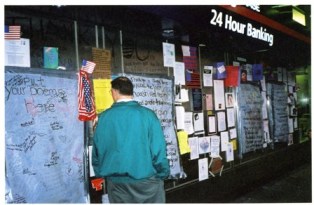
Near Ground Zero, New York City, September-October, 2001 (photos by Mary Ellyn Hutton)
|
Tears and concrete.
These were among the images called up by John Adams’ Pulitzer Prize-winning "On the Transmigration of Souls," which received its regional premiere Saturday night at the University of Cincinnati College-Conservatory of Music’s Corbett Auditorium.
The one-time-only event featured the CCM Concert Choir and Chorale, Cincinnati Children’s Choir and CCM Concert Orchestra, over 200 performers, led by Earl Rivers, director of choral studies and head of the division of ensembles and conducting at CCM.
Commissioned by the New York Philharmonic to commemorate the first anniversary of the 2001 World Trade Center attacks, the work includes a pre-recorded soundscape, with street noises and voices. Adams took his text from the list of 911 victims and excerpts from notes posted near Ground Zero and in the New York Times’ "Portraits of Grief" series.

Message board near Ground Zero, New York City, September-October, 2001
|
Though referential to 911, the work is more universal than that. The music is non-programmatic and has no religious content. Heavy with bass and broken by rivulets of strings (like tears) it’s a visceral embodiment of grief. The work’s climactic moments – huge, dissonant and shot through with pain – come coincident with "I wanted to dig him out, I know just where he is" and repetitions of "light" (implying hope, perhaps).
The multi-channel soundscape was heard in surround sound, with speakers onstage and flanking the audience. Mikes were placed strategically among the performers, who included an ensemble of three violins playing a quarter-tone sharp (there was also a quarter-tone piano). Depending on where one sat, more or less of the pre-recorded text could be heard at different points, but the overall effect was edgy, enveloping and profound.
Rivers led expertly, with complete command over the shifting meters and textures. The orchestra (CCM’s "second" orchestra!) sounded fully professional. The choruses were always audible and affecting, and the work received a warm ovation from the attentive audience (about ¾ of capacity).
The balance of the program, Brahms’ "Nänie" and Bernstein’s "Chichester Psalms," was led by CCM professor Stephen Coker. "Nanie," set to a dirge by Schiller on the transience of life and beauty, opened. The CCM choirs produced a warm, full sound, low-pitched and urgent on "Schöne vergeht" ("beauty must fade"), throbbing as the voices reached upward at the end.
Boy soprano Christian Betts made a fine impression in Psalm 23 of Bernstein’s "Chichester Psalms," sweet and accurate as he framed the choruses’ "Why do the nations rage" (Psalm 2). Coker struck up "Awake psaltery and harp" (Psalm 108) with a big steely sound and put lots of brawn in the rollicking "Make a Joyful Noise unto the Lord" (Psalm 100). The final movement was a beauty. The men’s voices and violas lulled the senses in Psalm 131, and solo work in both the chorus and orchestra (lush cellos) was outstanding.
(first published in The Cincinnati Post April 24, 2006)